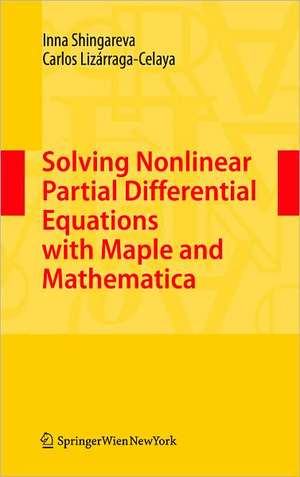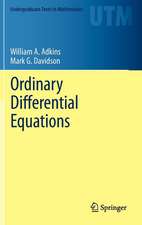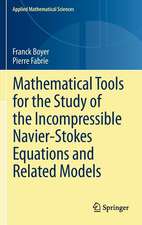Solving Nonlinear Partial Differential Equations with Maple and Mathematica
Autor Inna Shingareva, Carlos Lizárraga-Celayaen Limba Engleză Hardback – 24 iul 2011
| Toate formatele și edițiile | Preț | Express |
|---|---|---|
| Paperback (1) | 784.79 lei 6-8 săpt. | |
| SPRINGER VIENNA – 12 oct 2014 | 784.79 lei 6-8 săpt. | |
| Hardback (1) | 692.98 lei 3-5 săpt. | +28.60 lei 6-12 zile |
| SPRINGER VIENNA – 24 iul 2011 | 692.98 lei 3-5 săpt. | +28.60 lei 6-12 zile |
Preț: 692.98 lei
Preț vechi: 866.23 lei
-20% Nou
Puncte Express: 1039
Preț estimativ în valută:
132.61€ • 141.80$ • 110.56£
132.61€ • 141.80$ • 110.56£
Carte disponibilă
Livrare economică 28 martie-11 aprilie
Livrare express 13-19 martie pentru 38.59 lei
Preluare comenzi: 021 569.72.76
Specificații
ISBN-13: 9783709105160
ISBN-10: 3709105161
Pagini: 372
Ilustrații: XIII, 357 p.
Dimensiuni: 155 x 235 x 33 mm
Greutate: 0.69 kg
Ediția:2011
Editura: SPRINGER VIENNA
Colecția Springer
Locul publicării:Vienna, Austria
ISBN-10: 3709105161
Pagini: 372
Ilustrații: XIII, 357 p.
Dimensiuni: 155 x 235 x 33 mm
Greutate: 0.69 kg
Ediția:2011
Editura: SPRINGER VIENNA
Colecția Springer
Locul publicării:Vienna, Austria
Public țintă
ResearchCuprins
1 Introduction 1.1 Basic Concepts 2 Algebraic Approach 2.1 Point Transformations 2.2 Contact Transformations 2.3 Transformations Relating Differential Equations 2.4 Linearizing and Bilinearizing Transformations 2.5 Reductions of Nonlinear PDEs 2.6 Separation of Variables 2.7 Transformation Groups 2.8 Nonlinear Systems 3 Geometric-Qualitative Approach 3.1 Method of Characteristics 3.2 Generalized Method of Characteristics 3.3 Qualitative Analysis 4 General Analytical Approach. Integrability 4.1 Painlevé Test and Integrability 4.2 Complete Integrability. Evolution Equations 4.3 Nonlinear Systems. Integrability Conditions 5 Approximate Analytical Approach 5.1 Adomian Decomposition Method 5.2 Asymptotic Expansions. Perturbation Methods 6 Numerical Approach 6.1 Embedded Numerical Methods 6.2 Finite DifferenceMethods 7 Analytical-Numerical Approach 7.1 Method of Lines 7.2 Spectral Collocation Method; A Brief Description of Maple A.1 Introduction A.2 Basic Concepts A.3 Maple Language B Brief Description of Mathematica B.1 Introduction B.2 Basic Concepts B.3 Mathematica Language; References, Index
Recenzii
From the reviews:
“The authors consider the problem of constructing closed-form and approximate solutions to nonlinear partial differential equations with the help of computer algebra systems. … The book will be useful for readers who want to try modern methods for solving nonlinear partial differential equations on concrete examples without bothering too much about the mathematics behind the methods. Thus it is mainly of interest for applied scientists. Mathematicians may use it in connection with more theoretical works; some references are given throughout the book.” (Werner M. Seiler, Zentralblatt MATH, Vol. 1233, 2012)
“The authors consider the problem of constructing closed-form and approximate solutions to nonlinear partial differential equations with the help of computer algebra systems. … The book will be useful for readers who want to try modern methods for solving nonlinear partial differential equations on concrete examples without bothering too much about the mathematics behind the methods. Thus it is mainly of interest for applied scientists. Mathematicians may use it in connection with more theoretical works; some references are given throughout the book.” (Werner M. Seiler, Zentralblatt MATH, Vol. 1233, 2012)
Textul de pe ultima copertă
The emphasis of this work is on constructing different types of solutions (exact, approximate analytical, numerical, graphical) of numerous nonlinear PDEs correctly, easily, and quickly. The reader can learn a wide variety of techniques and solve numerous nonlinear PDEs included and many other differential equations, simplifying and transforming the equations and solutions, arbitrary functions and parameters, presented in the book). Numerous comparisons and relationships between various types of solutions, different methods and approaches are provided, the results obtained in Maple and Mathematica, facilitates a deeper understanding of the subject
Caracteristici
Presents different approaches for solving nonlinear PDEs and systems. Contains numerous examples and comparisons. Use of two computer algebra systems, Maple and Mathematica, enables comparisons between various types of solutions and approaches. Compact and understandable programming style of Maple and Mathematica helps to understand and solve nonlinear PDEs and many other differential equations Includes supplementary material: sn.pub/extras












